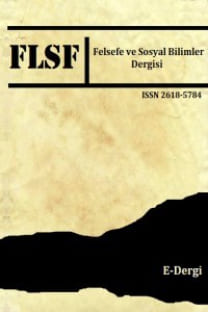Heidegger'de 'Herkes' Sorunsalı
THE PROBLEMATIC OF ‘THE THEY’ IN HEIDEGGER
Dasein, the They, Ordinariness, Publicness, Flatting, Meditation Art,
___
Althusser, L., İdeoloji ve Devletin İdeolojik Aygıtları, çev. Y. Alp & M. Özışık, İletişim Yayınları: İstanbul, 1994.Aristote, Éthique à Nicomaque, trad. par J.Tricot, Vrin: Paris, 2007.
Gasset, O. Y, İnsan ve “Herkes”, çev. N. G. Işık, Metis Yayınları, İstanbul, 1999.
Gözel, Ö., “Özne, Dil, Hakikat”, Öznenin Hakikat Kaygısı içinde, İz Yayınları: İstanbul, 2017.
Gözel, Ö., “Teknoloji ve Teemmül”, Öznenin Hakikat Kaygısı içinde, İz Yayınları: İstanbul, 2017.
Greisch, J., Ontologie et Temporalité: Esquisse d’une Interprétation Intégrale de Sein und Zeit, PUF: Paris, 2003.
Han, B.-C., Psikopolitika: Neoliberalizm ve Yeni İktidar Teknikleri, çev. H. Barışcan, Metis Yayınları: İstanbul, 2020.
Heidegger, M. ,Etre et Temps, trad. par F. Vezin, Gallimard: Paris, 1986.
Heidegger, M., “Pour servir de commentaire à Sérénité – Fragment d’un entretien sur la pensée”, trc: A. Préau, Questions III et IV içinde, trad. par. J. Beaufret vd., Gallimard, Paris, 1976; ss. 149-182.
Heidegger, M., Being and Time, trans. by J. Macquarrie & E. Robinson, Harper Collins Publishers: New York, 1962.
Heidegger, M., el-Keynûne ve’z-Zaman, tercüme-takdim-talik: Fethi el-Miskînî, Dâru’l-Kütübi’l-Vataniyye: Bingazi, Libya, 2013.
Heidegger, M., Prolégomènes à l’Histoire du Concept de Temps, Gallimard: Paris, 2006.
Heidegger, M., Sein und Zeit, Max Niemeyer Verlag: Tübingen, 2006.
Heidegger, M., Tekniğe Yönelik Soru, çev. D. Özlem, Afa Yayınları: İstanbul, 1997.
Heidegger, M., Varlık ve Zaman, çev. A. Yardımlı, İdea Yayınları: İstanbul, 2004.
Heidegger, M., Varlık ve Zaman, çev. K. H. Ökten, Alfa Yayınları: İstanbul, 2018.
Kockelmans, J. J., Heidegger’s “Being and Time”: The Analytic of Dasein as Fundamental Ontology, University Press of America: Washington, D.C., 1989.
Le Nouveau Petit Robert: Dictionnaire Alphabétique et Analogique de la Langue Française, Dictionnaires Le Robert: Paris, 2003.
Littré, E., Dictionnaire de la Langue Française, Librarie Hachette: Paris, 1918.
Uludağ, S., “Gaflet” md., TDV İslâm Ansiklopedisi, c. 13. cilt, TDV: İstanbul, 1996.
Uludağ, S., “Halvet der-Encümen” md., TDV İslâm Ansiklopedisi, c. 15, TDV: İstanbul, 1997.
Vaysse, J.-M., Dictionnaire Heidegger, Ellipses: Paris, 2007.
- Yayın Aralığı: Yılda 2 Sayı
- Başlangıç: 2006
- Yayıncı: Hamdi BRAVO
HUGO GROTIUS'UN DOĞAL HUKUK DÜŞÜNCESİNE KAZANDIRDIĞI PARADİGMAL DÖNÜŞÜM
HUSSERL'İN BAŞKASININ BENİNİN ARISTOTELES'İN DOST KAVRAMI ÜZERİNDEN YENİDEN DÜŞÜNÜLMESİ
Heidegger'de 'Herkes' Sorunsalı
ROUSSEAUCU LOGOSANTRİZM VE LAKONOFİLİ: SPARTA BİR MİTİK ÜTOPYA MIDIR POLİTİK ÜTOPYA MI?
Altın Bir Elma? Çağdaş Arapça ve Türkçe Araştırmalarda Leo Strauss'un Algısı Üzerine
ALTIN BİR ELMA? ÇAĞDAŞ ARAPÇA VE TÜRKÇE ARAŞTIRMALARDA LEO STRAUSS'UN ALGISI ÜZERİNE
SHAFTESBURY'DE DİN-AHLAK İLİŞKİSİ
ALTIN BİR ELMA? ÇAĞDAŞ ARAPÇA VE TÜRKÇE ARAŞTIRMALARDA LEO STRAUSS'UN ALGISI ÜZERİNE
